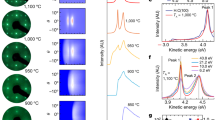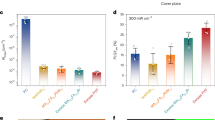Abstract
Oxide-based electronic devices are expected to have fascinating properties, unlike those made from conventional semiconductors. SrTiO3 (STO) is a key material for this new field of electronics1,2,3,4,5,6,7,8,9,10,11. Here we report on blue-light emission at room temperature from Ar+-irradiated, metallic STO. The irradiation introduces oxygen deficiencies to a depth of ∼20 nm from the crystal surface. These deficiencies generate conduction carriers and stabilize a hole level in a self-trapped state. We propose a model by which the doped conduction electrons and the in-gap state produce a radiative process that results in blue-light emission. The emitting region can be patterned into any size and shape with conventional microscopic fabrication techniques.
This is a preview of subscription content, access via your institution
Access options
Subscribe to this journal
Receive 12 print issues and online access
$259.00 per year
only $21.58 per issue
Buy this article
- Purchase on Springer Link
- Instant access to full article PDF
Prices may be subject to local taxes which are calculated during checkout





Similar content being viewed by others
References
Müller, K. A. & Burard, H. SrTiO3: an intrinsic quantum paraelectric below 4 K. Phys. Rev. B 19, 3593–3602 (1979).
Itoh, M. et al. Ferroelectricity induced by oxygen isotope exchange in strontium titanate perovskite. Phys. Rev. Lett. 82, 3540–3543 (1999).
Takesada, M., Yagi, T., Itoh, M. & Koshiahra, S. A gigantic photoinduced dielectric constant of quantum paraelectric perovskite oxides observed under a weak dc electric field. J. Phys. Soc. Jpn 72, 37–40 (2003).
Hasegawa, T., Mouri, S., Yamada, Y. & Tanaka, K. Giant photo-induced dielectricity in SrTiO3 . J. Phys. Soc. Jpn 72, 41–44 (2003).
Kawasaki, M. et al. Atomic control of the SrTiO3 crystal surface. Science 266, 1540–1542 (1994).
Koster, G., Korpman, B. L., Rijnders, G. J. H. M., Blank, D. H. A. & Rogalla, H. Quasi-ideal strontium titanate crystal surface through formation of strontium hydroxide. Appl. Phys. Lett. 73, 2920–2922 (1998).
Sugiura, M., Uragou, K., Tachiki, M. & Kobayashi, T. Estimation of trap levels in SrTiO3 epitaxial films from measurement of (LaSr)MnO3/SrTiO3/(LaSr)TiO3 p-i-n diode characteristics. J. Appl. Phys. 90, 187–191 (2001).
Bellingeri, E., Pellegrino, L., Marre, D., Pallecchi, I. & Siri, A. S. All-SrTiO3 field effect devices made by anodic oxidation of epitaxial semiconducting thin films. J. Appl. Phys. 94, 5976–5981 (2003).
Pallecchi, I., Pellegrino, L., Bellingeri, E., Siri, A. S. & Marre, D. Field effect on planar device made of epitaxial manganite perovskites. J. Appl. Phys. 95, 8079–8086 (2004).
Muller, D. A., Nakagawa, N., Ohtomo, A., Grazul, J. L. & Hwang, H. Y. Atomic-scale imaging of nanoengineered oxygen vacancy profiles in SrTiO3 . Nature 430, 657–661 (2004).
Muraoka, Y., Muramatsu, T., Yamaura, Y. & Hiroi, Z. Photogenerated hole carrier injection to YBa2Cu3O7−x in an oxide heterostructure. Appl. Phys. Lett. 85, 2950–2952 (2004).
Suzuki, H. et al. Superconductivity in single-crytstallines Sr1−xLaxTiO3 . J. Phys. Soc. Jpn 65, 1529–1532 (1996).
Schooley, J. F. et al. Superconductivity in semiconducting SrTiO3 . Phys. Rev. Lett. 12, 474–475 (1964).
Tufte, O. N. et al. Electron mobility in semiconducting strontium titanate. Phys. Rev. 155, 796–802 (1967).
Henrich, V. E., Dresselhaus, G. & Zeiger, H. J. Surface defects and the electronic structures of SrTiO3 surfaces. Phys. Rev. B 17, 4908–4921 (1978).
Pontes, F. M. et al. Photoluminescence at room temperature in amorphous SrTiO3 thin films obtained by chemical solution deposition. Mater. Chem. Phys. 77, 598–602 (2002).
Grabner, L. Photoluminescence in SrTiO3 . Phys. Rev. 177, 1315–1323 (1969).
Feng, T. Anomalous photoelectric process in SrTiO3 . Phys. Rev. B 25, 627–641 (1982).
Leonelli, R. & Brebner, J. L. Time-resolved spectroscopy of the visible emission band in strontium titanate. Phys. Rev. B 33, 8649–8656 (1986).
Hasegawa, T., Shirai, M. & Tanaka, K. Localizing nature of photo-excited states in SrTiO3 . J. Lumin. 87, 1217 (2000).
Capizzi, M. & Frova, A. Optical gap of strontium titanate. (Deviation from urbach tail behavior). Phys. Rev. Lett. 25, 1298–1302 (1970).
Matteiss, L. F. Effect of the 110 ∘K phase transition on the SrTiO3 conduction bands. Phys. Rev. B 6, 4740–4753 (1972).
Mochizuki, S., Fujishiro, F. & Minami, S. Photoluminescence and reversible photo-induced spectral change of SrTiO3 . J. Phys. C 17, 923–948 (2005).
Müller, K. A., Berlinger, W. & Waldner, F. Characteristic structural phase transition in perovskite-type compounds. Phys. Rev. Lett. 21, 814–817 (1968).
Shirane, G. & Yamada, Y. Lattice-dynamical study of the 110 ∘K phase transition in SrTiO3 . Phys. Rev. 177, 858–863 (1969).
Ihrig, H., Hengst, J. H. T. & Klerk, M. Conductivity-dependent cathodeluminescence in BaTiO3, SrTiO3 and TiO2 . Z. Phys. B 40, 301–306 (1981).
Acknowledgements
The authors are grateful to S. Kasai for his assistance in the photolithography. Thanks are also due to K. Matsuda and H. Hirori for their assistance in the photoluminescence measurements. This work was partly supported by the Grant-in-Aids for COE Research on Elements Science (No. 12CE2005), Scientific Research on Priority Areas (No. 751), and Scientific Research (No. 17105002) from the Ministry of Education, Culture, Sports, Science and Technology (MEXT) of Japan.
Author information
Authors and Affiliations
Corresponding author
Ethics declarations
Competing interests
The authors declare no competing financial interests.
Rights and permissions
About this article
Cite this article
Kan, D., Terashima, T., Kanda, R. et al. Blue-light emission at room temperature from Ar+-irradiated SrTiO3. Nature Mater 4, 816–819 (2005). https://doi.org/10.1038/nmat1498
Received:
Revised:
Accepted:
Published:
Issue Date:
DOI: https://doi.org/10.1038/nmat1498
This article is cited by
-
Tailoring the Influence of Hybrid SiC/SrTiO3 Nanomaterials Doped PMMA/PEO for Promising Nanodielectric and Nanoelectronic Applications
Silicon (2024)
-
Designing Pr-based advanced photoluminescent materials using machine learning and density functional theory
Journal of Materials Science (2024)
-
Construction of quantum well surface from an Nb surface–doped core-shell La-SrTiO3 nanocubes for photocatalytic hydrogen production
Advanced Composites and Hybrid Materials (2023)
-
Study of the solar perovskites: XZnF3 (X = Ag, Li or Na) by DFT and TDDFT methods
Journal of the Korean Ceramic Society (2023)
-
Laser Irradiation Induced Atomic Structure Modifications in Strontium Titanate
JOM (2022)



